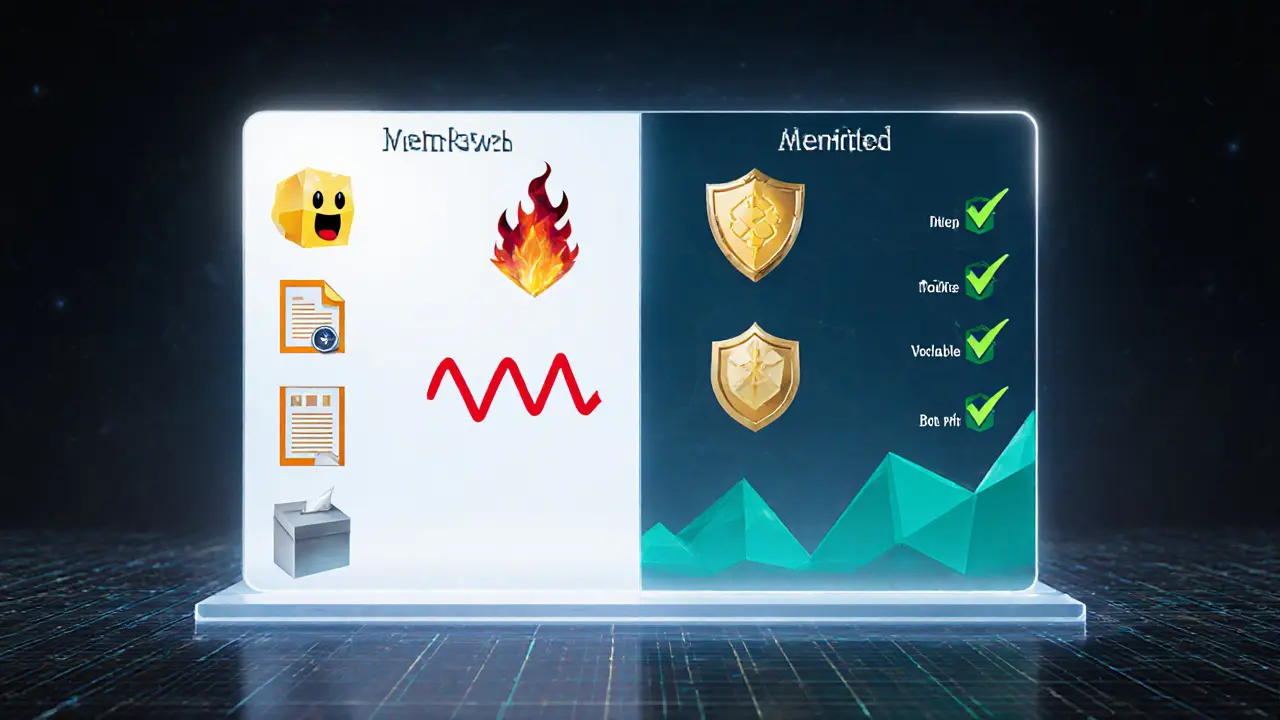Memecoin vs Serious Crypto: Risks, Returns & Investment Guide

Memecoin vs Serious Crypto Investment Analyzer
Use this tool to evaluate whether a cryptocurrency project aligns more with memecoin or serious crypto characteristics. Enter details below to see a detailed comparison.
Analysis Results
If you’ve been scrolling through crypto forums lately, you’ve probably seen the same debate over and over: memecoin vs serious crypto. One side promises moon‑shot gains fueled by memes, the other offers tech‑heavy solutions that aim to reshape finance, gaming, and beyond. Below you’ll find a plain‑English breakdown of what each camp actually delivers, how they differ technically, and what the numbers say about risk and reward.
TL;DR
- Serious crypto projects (Ethereum, Cardano, Polkadot, etc.) focus on real‑world use cases, have audited code, and attract long‑term investors.
- Memecoins (Dogecoin, Shiba Inu, Pepe, etc.) thrive on social hype, have minimal technical innovation, and are prone to extreme price swings.
- Average 2024 volatility: serious projects ~60% YoY, top memecoins >200% YoY.
- Long‑term staking yields on serious projects range from 4%‑12%; memecoin yields are usually promotional and can disappear.
- Regulators are tightening on memecoins - the SEC introduced compliance checks in 2025, adding another hurdle for developers and traders.
What Are Memecoins?
At their core, a memecoin is an altcoin that rides on internet jokes, viral trends, or celebrity tweets. The first big hit was Dogecoin, launched in 2013 as a playful nod to a Shiba Inu meme. Since then, dozens of spin‑offs - Shiba Inu, Pepe, Floki Inu - have emerged, each promising massive upside if the next meme goes viral.
Technically, most memecoins sit on existing blockchains like Ethereum or BNB Smart Chain. They inherit the base layer’s security but rarely add new features. Their tokenomics are often simple: a fixed supply, a few percent burned each transaction, and community‑driven marketing pushes on Twitter, TikTok, and Discord.
What Are Serious Cryptocurrency Projects?
In contrast, serious cryptocurrency projects aim to solve specific problems with blockchain tech. Ethereum introduced programmable smart contracts, enabling DeFi, NFTs, and decentralized apps. Cardano focuses on peer‑reviewed research and formal verification, while Polkadot offers cross‑chain interoperability. Ripple targets fast, low‑cost cross‑border payments for banks. These projects invest heavily in research, security audits, and developer tooling.
Because they are built to be platforms, serious projects feature robust governance models, token‑holder voting, and incentives for validators or stakers. Their roadmaps span years, and many have already been integrated into enterprise‑grade solutions.
Technical Differences at a Glance
| Attribute | Memecoins | Serious Projects |
|---|---|---|
| Primary Purpose | Community hype, speculative trading | Infrastructure, real‑world use cases |
| Smart Contract Support | Usually inherits from host chain (e.g., ERC‑20) | Native platforms with full VM (e.g., EVM, Plutus) |
| Governance Model | Informal, social‑media driven | Formal on‑chain voting, token‑holder proposals |
| Security Audits | Rare, often none | Regular third‑party audits, bug‑bounty programs |
| Scalability Solutions | Dependent on host chain (e.g., layer‑2 rollups) | Built‑in sharding, parachains, sidechains |
| Typical Development Cycle | Launch → hype → decay (months) | Iterative upgrades (years) |
These differences translate into very distinct risk profiles, which we’ll break down next.

Investment Risks & Returns
When you look at price charts, the contrast is stark. In 2024, the average 30‑day swing for top memecoins hit 180%, while leading serious projects stayed under 70%.
Risk factors unique to memecoins include:
- Extreme volatility driven by viral trends rather than fundamentals.
- Absence of audited code, making smart‑contract exploits common.
- Regulatory crackdowns - the SEC began requiring compliance checks for meme tokens in 2025, adding legal uncertainty.
- Rug pulls and liquidity drains - the $TRUMP meme token lost over 60% of its market cap in a single week after the creator vanished.
Serious projects, while still volatile, typically offer:
- Fundamental demand from DeFi, gaming, or enterprise users.
- Transparent development roadmaps and community governance.
- Staking rewards that provide passive income (e.g., 5‑10% APY on Ethereum’s ETH2 or 8% on Cardano’s ADA).
- Lower incidence of total loss - even during bear markets, core networks retain a baseline value.
Historical data from Token Metrics shows ETH’s base‑case price target at $5,700 for 2025, while SOL is projected around $630. Those targets are built on liquidity, active user growth, and capital rotation patterns. In comparison, the highest‑performing memecoin of 2024 delivered a 12x return, but the median memecoin fell flat or lost half its value.
Regulatory Landscape in 2025
The crypto‑regulation wave has hit memecoins hardest. The SEC introduced a “Meme Token Registration” requirement in March 2025. Projects that fail to file a Form 1‑K style disclosure face delisting from US‑based exchanges and potential civil penalties.
Serious projects have been proactive. Ethereum’s development community engaged with the EU’s MiCA framework early, positioning ETH as a qualified “crypto‑asset” under the new rules. Cardano’s team partnered with several European fintech firms to ensure compliance, giving institutional investors confidence.
For traders, the takeaway is clear: if you’re chasing quick gains, expect tighter KYC/AML checks and possible exchange suspensions for memecoins. If you prefer a longer horizon, serious projects are already building the compliance scaffolding needed for mainstream adoption.
How to Evaluate a Token - A Practical Checklist
- Purpose & Use‑Case: Does the token solve a real problem (e.g., cross‑chain messaging) or is it merely a meme?
- Team & Governance: Look for known developers, open‑source repos, and on‑chain voting mechanisms.
- Security Audits: Verify third‑party audit reports; avoid tokens with “no audit” flags.
- Tokenomics: Check supply caps, emission schedules, and any burn mechanisms that affect scarcity.
- Liquidity & Exchange Listings: Tokens listed on reputable exchanges (Kraken, KuCoin) are less prone to price manipulation.
- Regulatory Status: Confirm whether the token complies with the latest SEC or local regulator guidelines.
- Community Health: Active Discord/Telegram, transparent updates, and developer engagement are good signs.
For a quick visual, here’s a rating matrix borrowed from Token Metrics’ dual‑grade system:
- Trader Grade (short‑term): Focuses on hype, volume spikes, and social sentiment - ideal for memecoins.
- Investor Grade (long‑term): Weighs fundamentals, security, and adoption - best for serious projects.
Real‑World Scenarios - When to Choose Which
Scenario 1: You have $5,000 to allocate over the next 12 months. A balanced approach works. Put 70% into staking‑ready serious assets like ETH, ADA, or DOT, and keep 30% for high‑risk, high‑reward meme tokens you’ve vetted for community momentum. This way, you earn passive yields while keeping a small shot at a meme‑driven surge.
Scenario 2: You’re a day trader looking for daily price swings. Focus on the Trader Grade list from Token Metrics. Identify memecoins that just entered a trending hashtag wave, set tight stop‑losses, and monitor volume on exchanges. Remember that the average downside on a meme token can be >15% in a single day.
Scenario 3: You manage a corporate treasury. Stick to serious projects with proven enterprise partnerships. Ripple (XRP) for cross‑border payments, or Ethereum for smart‑contract based escrow systems, align with compliance requirements and reduce exposure to meme‑driven volatility.
Next Steps & Troubleshooting
If you’re new to crypto, start with a reputable exchange, buy a modest amount of ETH or ADA, and practice staking on the platform’s built‑in dashboard. Simultaneously, set up a separate wallet for experimental meme tokens, but limit exposure to less than 5% of your total crypto net worth.
Common pitfalls and how to avoid them:
- Falling for pump‑and‑dump schemes: Verify that a token’s liquidity isn’t solely held by a few wallets.
- Ignoring audit reports: Always read the audit summary; missing code review is a red flag.
- Neglecting tax obligations: In many jurisdictions, crypto gains are taxable. Keep transaction records.
- Overlooking gas fees: On Ethereum, meme token trades can cost more in gas than the trade value during network congestion.
By applying the checklist above and staying disciplined, you can navigate both the meme‑driven rollercoaster and the steady climb of serious blockchain projects.

Frequently Asked Questions
Are memecoins a good long‑term investment?
Most memecoins lack intrinsic utility and rely on viral hype, making them unsuitable for long‑term holding. A small allocation for speculative trades can be justified, but the core of a portfolio should focus on serious projects with real use cases.
What security risks should I watch for with meme tokens?
Key risks include unaudited smart contracts, centralized liquidity pools that can be rug‑pulled, and phishing scams that mimic popular meme communities. Always verify audit reports and inspect token contract ownership before buying.
How do staking rewards differ between serious projects and memecoins?
Serious projects like Ethereum (ETH2), Cardano (ADA), or Polkadot (DOT) provide predictable staking yields ranging from 4%‑12% and are backed by protocol‑level incentives. Memecoins may offer promotional APYs that can be revoked at any time, and many simply don’t have staking mechanisms at all.
Will the SEC’s meme‑token regulations kill new meme projects?
The rules raise the compliance bar, so many small creators may stop launching new memes. However, established tokens that can meet filing requirements will survive, and new projects may emerge on jurisdictions with lighter oversight.
Is it better to trade memecoins on centralized exchanges or DEXs?
Centralized exchanges (CEXs) like Kraken provide better liquidity and regulatory safeguards, while decentralized exchanges (DEXs) offer anonymity but higher slippage and risk of fraudulent token listings. For safety, start on a reputable CEX.

Kate Roberge
August 7, 2025 AT 19:33Honestly, the whole memecoin hype train feels like a circus without a ringmaster. While the guide tries to be balanced, it glosses over how many of these projects collapse faster than a bubble gum bubble in a hurricane. If you’re looking for real utility, stick to protocols with audited code and a roadmap that isn’t written on a napkin. Memes might get you to the moon, but they’ll also leave you stranded on a crater. Treat the hype with a grain of salt and a healthy dose of skepticism.
Jason Brittin
August 8, 2025 AT 17:54Whoa, memecoins are basically the "funny cat videos" of crypto – they’re addictive, cheap, and you never know when the algorithm will change! 😂 If you enjoy roller‑coasters, grab a ticket, but keep a safety net of serious assets in your portfolio. The guide nails the risk part, but remember that meme tokens can disappear faster than a meme trend on TikTok. 🚀💎
VICKIE MALBRUE
August 9, 2025 AT 16:16Great breakdown, very clear. Focus on fundamentals and you’ll stay safe. Diversify early and you’ll see the benefits over time.
april harper
August 10, 2025 AT 14:37One might argue that memecoins are the modern embodiment of Sisyphus, eternally rolling up the hill of hype only to tumble down into obscurity. Yet, in that very act lies a philosophical mirror reflecting humanity’s craving for instant gratification. Serious projects, on the other hand, tread the slow path of enlightenment, building structures that may endure beyond our lifetimes. It is a dance between fleeting delight and lasting legacy, and each investor must choose which rhythm resonates within them.
Waynne Kilian
August 11, 2025 AT 12:59I think it’s cool how the guide points out both sides. Memecoinz can be funnies but also risky – real projects need solid foundations. Let’s not be too hasty to write them off, but also not jump in blindly. Collaboration and open discussion help us all learn.
Rajini N
August 12, 2025 AT 11:20The checklist you provided is an excellent starting point for newcomers. I would add a reminder to verify the provenance of audit reports, as some projects publish fabricated documents. Additionally, always check the token’s contract for owner privileges that could enable a rug pull. Staying vigilant and methodical will greatly reduce exposure to common pitfalls.
Oreoluwa Towoju
August 13, 2025 AT 09:42Stick to audited tokens, watch liquidity, and keep meme exposure low.
Amie Wilensky
August 14, 2025 AT 08:03Wow, what a comprehensive guide, but let’s be real: the crypto space is filled with noise, hype, and endless speculation; you can’t possibly cover every angle in a single post, can you? Still, it’s a solid effort; kudos for the tables and checklists-those really help when you’re drowning in data.
Kate Nicholls
August 15, 2025 AT 06:25The guide nails the core differences, but it could use a bit more emphasis on the long‑term sustainability of serious projects. Memecoins are fun, yet their lifespan is usually measured in weeks, not years.
Jacob Anderson
August 16, 2025 AT 04:46Sure, memecoins are the “future of finance” … if you consider a circus act a financial strategy. Seriously, most of them are built on hype, not substance, and the SEC is already cracking down. Stick to real tech if you don't want your portfolio to implode.
Ben Dwyer
August 17, 2025 AT 03:08Good info – keep a balanced portfolio.
Katrinka Scribner
August 18, 2025 AT 01:29OMG this guide is sooo helpful!! 😂💥 I love how it breaks down the risks – makes me feel less scared to dabble a bit in memecoins, but still keep my feet on the ground with serious projects. Thanks for the clear step‑by‑step checklist!!
Billy Krzemien
August 18, 2025 AT 23:51The practical steps are spot‑on. I’d suggest also monitoring gas fees, especially on Ethereum, as they can erode any meme‑token gains during peak network congestion.
Clint Barnett
August 19, 2025 AT 22:12Reading through this guide feels like embarking on an educational odyssey through the ever‑shifting landscape of digital assets. First, the delineation between memecoins and serious projects offers a clear bifurcation, allowing investors to swiftly categorize opportunities. Yet, the nuances go deeper: while memecoins thrive on virality, their underlying technology often mirrors that of their more serious counterparts, inheriting both security strengths and vulnerabilities from the host chain. Consequently, a diligent investor must scrutinize not only the token’s utility but also the robustness of the underlying infrastructure. The volatility metrics presented underscore a stark reality-memecoins can experience price swings exceeding 200% YoY, a double‑edged sword that promises astronomical gains but equally terrifying losses. In contrast, established platforms like Ethereum or Cardano demonstrate more tempered volatility, typically hovering around 60% YoY, which aligns with a risk‑adjusted return model suited for longer horizons. Moreover, the guide’s emphasis on audit status cannot be overstated; an unaudited smart contract is akin to a house built on sand, vulnerable to exploits that can decimate community trust overnight. Security audits, particularly third‑party reviews, serve as a form of architectural certification, providing a layer of assurance that the code behaves as intended under adversarial conditions. The regulatory outlook paints a sobering picture for meme tokens, especially with the SEC’s recent enforcement measures that mandate formal disclosures. Compliance, while burdensome, may act as a filter, weeding out projects lacking the resources or intent to meet statutory obligations, thereby potentially elevating the overall health of the ecosystem. Conversely, serious projects have already begun aligning with frameworks such as the EU’s MiCA, positioning themselves for institutional adoption. The checklist at the article’s conclusion offers a pragmatic roadmap: purpose, team, audits, tokenomics, liquidity, regulatory status, and community vitality. Each pillar represents a critical axis of due diligence, and neglecting any can lead to sub‑optimal investment outcomes. For instance, a token with solid technical foundations but a toxic community may face coordinated sell‑offs, while a token with a vibrant community but opaque governance could suffer from decision‑making paralysis. Finally, the scenario analysis provides actionable guidance for varying investor profiles-whether you are a day trader seeking rapid price movements, a long‑term holder aiming for sustainable yields, or a corporate treasury focused on compliance and stability. By internalizing these frameworks, investors can navigate the crypto sphere with a calibrated blend of optimism and caution, thereby optimizing their risk‑return profile while safeguarding against the capricious nature of meme‑driven markets.
Charles Banks Jr.
August 20, 2025 AT 08:45Ah, Jacob’s take on memecoins being a circus-classic. While the circus may be loud, it still draws a crowd, and sometimes the crowd’s enthusiasm is what fuels the next big tech breakthrough.